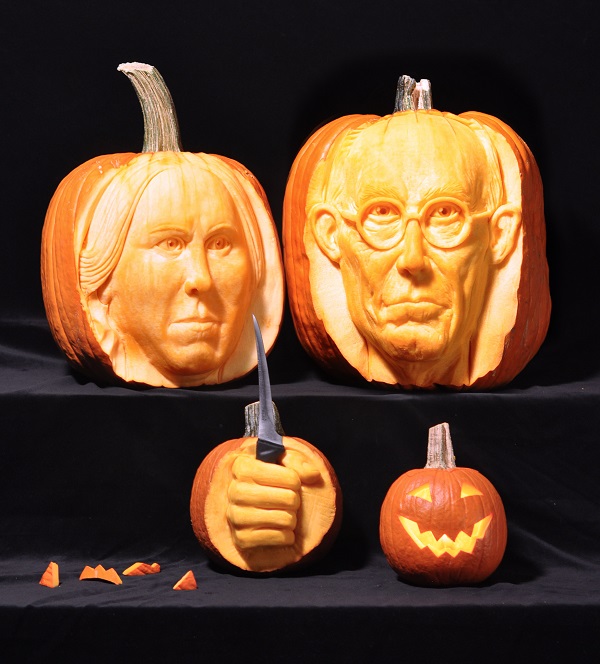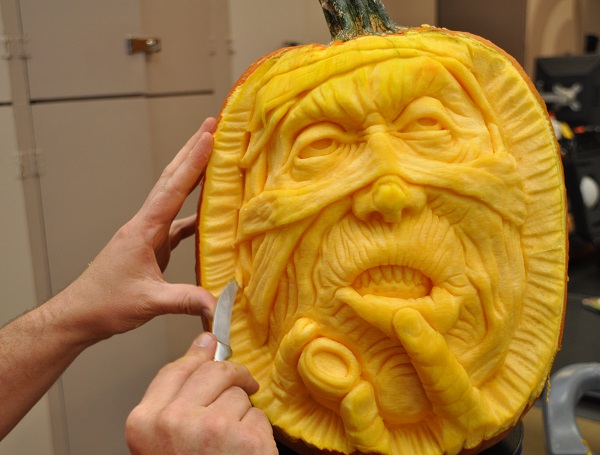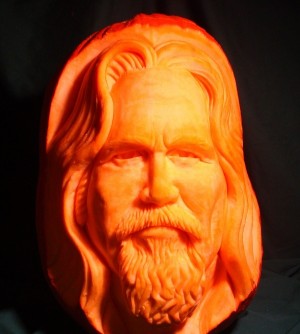Artist of the Week 10/30-11/5: The Many Faces of Scott Cummins
Pumpkin carving has been a longtime Halloween tradition for many, but there is one artist who takes this art form to completely new heights.
From an uncannily picture-perfect rendition of “The Dude” from the film The Big Lebowski to sinister and whimsical pumpkin faces with crooked grins and glaring eyes, these are just some of the intricately detailed pumpkin carvings you will find in Scott Cummins’ oeuvre. Taking no more than two hours to render a work complete, Cummins carefully works his magic on the rind of the pumpkin with the help of his peeling knives and wood carving tools. And while you might think that Halloween would be his favorite holiday, the self-proclaimed Pumpkin Gutter says that it is far from it, despite the fact that the fruit is aplenty this time of year. For Cummins, the goosebump rising holiday merely reminds him of the few remaining days his carvings have left to come to life, seeing as pumpkin season ends rather abruptly for the cream of the crop after the last of the trick-or-treaters has settled in after their dizzying candy high.
Taking inspiration from popular culture, the art teacher from Perryton, Texas has been carving pumpkins since he can remember. However, despite the overarching popularity that his carvings have received over the last few years, he hasn’t let it overtake his life. Deeming it as his hobby, instead of a career, he puts his heart into every piece as if it were a clay sculpture to be displayed in the center of a museum. And perhaps it is his passion for the creations and his canvas choice that renders his artwork timeless, despite its permeable nature.
Just in time for All Hallows’ Eve, Cummins shared his thoughts on the pumpkin carving process, why he only carves faces, and his rather peculiar choice of studio.
GALO: Your three-dimensional pumpkin carvings are intricately detailed. From sinister smiles showing teeth and wrinkled foreheads to glowing gorillas, zombies, pharaohs and even Einstein and Yoda – how hard is it to carve the desired look into this vegetable and what difficulties do you tend to encounter with this material when carving? For instance, does it ever unexpectedly break apart, especially when hollowing it out?
Scott Cummins: Pumpkin rind actually carves very easily. The limitations of pumpkin carving are manifested more in working with the limited thickness of the rind. Also, when one begins to carve very tiny details, the coarse grain of the inner rind can begin to present problems. Being a subtractive technique, one must take care to only remove what they intend to. Generally speaking, once the material is removed, it can’t be replaced. It’s also difficult to get consistent results if you take too long on a carving. The texture of the rind begins to change after it is exposed to air in ways that have a negative impact on the carving process. Hollowing out a pumpkin is done prior to carving and, because of this, never presents a problem.

One of artist Scott Cummins’ pumpkin carvings. Photo Courtesy of: Scott Cummins.
GALO: Why pumpkins — is it the size, the weight? Have you considered working with other vegetables or fruit for carving purposes?
SC: Pumpkins are my medium of choice due to the traditional history behind it…nothing more. I’ve carved a few other vegetables out of curiosity but they hold no lasting interest for me.

Scott Cummins at work carving a pumpkin. Photo Courtesy of: Scott Cummins.
GALO: A vegetable, unlike other substances such as clay or stone, is a transient element that disappears rather quickly due to rotting and drying out — though one can have them last for as long as two weeks with very few signs of rot through chemical treatment. How does it make you feel to have your art predisposed to such metamorphose circumstance for which you have no control over?
SC: The fact that they deteriorate so rapidly and reliably is probably my favorite thing about carving pumpkins. I make no significant attempts to preserve them, other than wrapping them in a bag and keeping the temperature cool — with the obvious exception of photographing them. People in general, I believe, are intrigued by all things temporary. Most everyone has found themselves admiring sand or snow sculptures, ice carvings, or even elaborately decorated cakes. Pumpkin carving appeals to that same fascination in everyone. Some interpret the ephemeral qualities as a negative. But in reality, if my carvings were in wood or Styrofoam, few people would take the time to seek them out. Not to mention that I would have no interest in creating them.
(Interview continued on next page)

